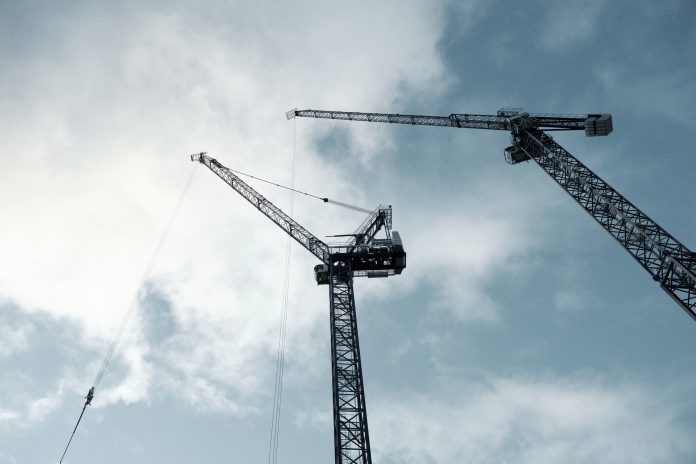The coronavirus pandemic is challenging for all industries, Alison Knight of Buildworld explores what builders can do to maintain construction during Covid-19
The UK’s 35% drop in construction productivity has highlighted how builders need to follow updated guidelines to get back on track.
The government’s HMRC coronavirus Job Retention Scheme was extended until the end of October 2020, which provided relief to a large number of contractors.
Even so, the industry has slowed down and suffered during the pandemic, and a new plan of action is needed to keep it afloat.
As further research into Covid-19 is conducted, and United Kingdom infection rates spike again, additional adjustments are being made.
Transport for London has just released new travel advice for construction workers returning to work. This advice is in line with the authorities’ policy to place industry at the heart of its Covid-19 recovery programme.
Concurrently, the Construction Product Association is warning against significant drops in construction output in 2020, and into 2021. The upshot of all of this is that building must continue as normally as possible to boost the economy, but large groups of workers need to be kept safe at the same time.
How does a builder maintain standards of safety and quality with the threat of the novel coronavirus ever-present? What are the guidelines for construction during the pandemic?
Governmental guidelines
Among the various official recommendations published by authorities, the one that applies most to the construction industry is the Business, Energy, and Industrial Strategy Department’s regulations for outdoor work.
The stipulations were prepared with input from the Health and Safety Executive, Public Health England, unions, firms and industry bodies.
Guidelines include:
- Workers should be 2m part (the social distancing recommendation) or 1m (if 2m is not viable) apart whenever possible. These distances can be indicated with floor markings.
- Proper risk assessments must be carried out using the official Health and Safety Executive guides.
- Employers should regularly discuss the situation with their workforce to get their buy-in and keep them updated as to what’s going on.
- Anyone who feels ill, has a temperature or is coughing shouldn’t enter a site.
- Handwashing and surface cleaning must be dramatically increased. The regulations don’t specify exactly how to do this, but placing sanitiser, wash stations, paper towels and soap at strategic points around a job site has proven very effective.
- Where possible, people ought to continue to work from home. Face-to-face meetings should be limited to ten people and held outside if the weather permits. Those who are particularly vulnerable, such as the elderly or people with chronic diseases, need to be especially careful.
- Back-to-back and side-to-side rather than face-to-face working should be practised wherever feasible.
- Specific employees can be partnered or grouped to reduce the number of different people that every individual is exposed to.
- Worker arrival, departure, break times, and shifts should be staggered to avoid having too many people on-site at the same time. In the construction industry, this is vital as different subcontractors frequently come and go and there’s no real way of checking they’re following proper precautions.
- Weather permitting, breaks should be taken in the open air.
- Entrances and exits should be separated, so that foot traffic only moves in one direction.
- Inbound and outbound goods must be dropped off and collected at designated points and sanitised before being brought into the workplace.
- Using the same driver for all deliveries will minimise contact and infection risk.
Additional advice
The Construction Leadership Council and other trusted sources have also published guidelines to prevent the spread of infection. The measures are highly recommended but not legally required, and include:
- Implementing a no-handshake policy.
- Prohibiting the sharing of utensils and food.
- Regular disinfecting of high-touch areas. Such as shared tools, scaffolding, rest areas and crew vehicles.
- Temperature checks of anyone entering the premises.
- Touching the eyes, nose, mouth and other parts of the face should be kept to a minimum.
- Avoid face-to-face client meetings by communicating via email, text, telephone, video conferences or site inspections.
- Tissues should all be thrown in a rubbish bin designated for that purpose.
- Face coverings are not mandatory for construction workers on a job unless they were part of the pre-lockdown Personal Protective Equipment requirements. The government’s official line is that in other situations, social distancing, hygiene and fixed teams or partnering should be enough to mitigate the risk. However, many companies have chosen to enforce facemasks.
All hands on deck
Anyone looking through the official government or other organisations’ guidelines will notice that they’re all dependent on the results of a project’s risk analysis. The phrase “steps that will usually be needed” is often used because precautions can only be decided once the specific risk factors have been established.
The message seems clear; contractors need to do their best to stay updated on research and regulations. They need to comply with whatever stipulations apply to their projects while using their judgement and common sense.
The guidelines that apply to staying safe while doing outdoor jobs like tiling a roof or digging a drainage trench will differ from indoor construction, such as laying flooring or wiring. The onus is on the site manager to ensure that all parties take appropriate action at every stage.
Project managers are advised to keep employees educated and informed at all times. Not only will this help to keep the information fresh so they can continue to comply with Covid-19 safety measures, but it will also foster a sense of teamwork and everyone being in this crisis together.
People will be motivated to work harder and notify management if they see anything that looks amiss – like an empty soap dispenser – which could make all the difference to stopping the spread of coronavirus on a job site.
Education sessions scheduled into workdays and posters issuing handwashing and social distancing reminders should become regular features on building firms’ schedules and budgets. As an additional precaution, supervisors should have regular discussions with their team to determine if they feel adequately protected and what changes they think should be made.
The global pandemic has affected the economy at all levels. It will take time and money to continue the construction business and recover when the outbreak is finally over. Thinking about all risk mitigation decisions and involving employees in an all-hands-on-deck approach is the best way for building companies to bounce back quickly.

Alison Knight
Editor-in-Chief















In our private gated block of 73 flats reside many infirmed, elderly residents. One owner insists on continuing non essential refurbishment to rent out her second property. Her builders have to use the only entrance, communal stairway and lift and a long corridor all day carrying materials in and waste out passing many front doors of vulnerable concerned residents. The noise from demolishing walls, drilling concrete etc is distressing during this enforced lockdown. It also makes working from home (zoom etc) almost impossible. As Chair of the residents association I have recommended by newsletter there should be no unnecessary tradespeople on site as happened with the previous lockdown. I am very concerned for the health and safety of our residents when this owner says construction work is permitted by the government. Where do we stand on this?